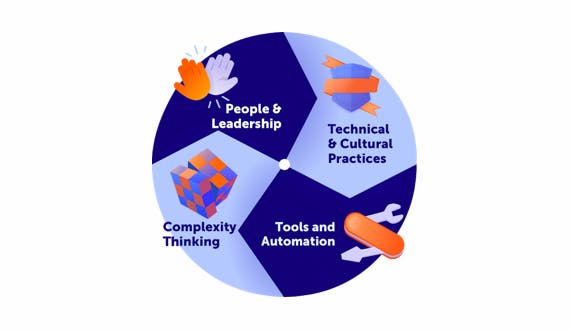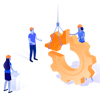In the third blog of this series, Heidi Araya, Agile Transformation Leader and creator of the Four facets of agility, unpacks the roadblocks inherent with agile transition and explains how the Four facets of agility help organisations to reframe their thinking. Take a look at parts 1 and 2 to get up to speed. Here, she explores the second fundamental facet to successful transformation: people and leadership.

A workplace is nothing without its people. But because people like shiny things and fancy tech, when it comes to agile transformation, most organisations throw all their resources behind processes and tools—forgetting about the humans and the effective interactions required to make everything happen. They fail to empower leaders and teams with an agile mindset, and as a result, their agility will always be half-baked.
What is an ‘agile mindset’?
This term is no spring chicken – we’ve been talking about its importance for years. But some people are still in the dark when trying to define it. As recently as May 2020, Forbes contributor and author of The Age of agile, Steve Denning, listed a number of sometimes contradictory definitions and was left asking, ‘Is it possible that we in the agile community have been putting too much emphasis on such an undefined and ambiguous term?’ At Adaptavist, we think the answer is a resounding, ‘No!’
When it comes to the complex challenges businesses face, rewiring our thinking can’t be emphasised enough. Conventional thought processes are severely lacking. Our research shows that when the complexity in our environment exceeds the complexity of our psychology, problems inevitably arise. From high anxiety that hampers performance to low morale and feeling unfulfilled, leaving agile processes unmanned by agile minds is inertia waiting to happen.

Constructing new meaning
It’s simply not enough to put people through their paces with a Scrum or SAFe® class and assume their journey to an agile mindset is complete. Agile is not something you ‘get’ in an instant, whether or not you have the certificate to prove it. Don’t just take my word for it. We asked psychologists to help us better understand how humans make meaning of the world and whether we’re able to shift our thinking.
They explained the constructivist theory – whereby each person constructs their own meaning, influenced by previous learning and new knowledge. It argues that learning is active, rather than passive. We truly understand not by absorbing information but through engaging with the world around us. It reinforces what Adaptavist knows to be true: you can’t obtain an agile mindset in the classroom. You develop one through putting agile principles into practice, in your day-to-day work and life.
Beyond convention
It turns out, as we develop in adulthood, we move through different identifiable stages of psychological development too. The Leadership Development Framework (LDF) is a tool built on the premise that we all have the potential for continued growth. Through motivation and support, we can find new ways to problem-solve, interpret, and interact with our environment. We’ve been using this framework to help understand how our clients, particularly those in leadership roles, are likely to interpret situations and, as a result, how they will act.
There are two broad strokes of adult development and meaning-making: conventional and post-conventional. Let’s take a look at how they differ.
Conventional:
This is what most people fall into. It’s the frame of mind concerned with control, measurement, and prediction. If you believe you can disassemble just about anything into its component parts and put it back together again, you probably fall into this camp. You pursue goals in terms of output; you feel like you can control most situations and it’s possible to predict outcomes.
Post-conventional:
Post-conventional thinking is much rarer – only about 10 percent of the population achieve it. With a post-conventional mindset, you understand situations are complex and interact in many different ways, realising you cannot simply disassemble and reassemble. You see the world as a living system and most situations as impossible to predict and control. And, even more, you recognize your own assumptions about the world.
Take a guess at which of these world views suits an agile mindset? Post-conventional thinking is vital for successful agile leadership. But to help C-suiters develop, they need to know where they’re at and how to move forward. We use dialogue partnering, a collaborative inquiry into how people make meaning, to support business leaders on their journey to a post-conventional point of view.

Time to change your mindset?
No matter where you are on your agile transformation journey, Adaptavist’s experts are here to help.
A meeting of minds
Understanding your own mindset is invaluable, but no person is an island, especially in business. The way you think and see the world is intrinsically linked to both the network you’re part of, in other words your colleagues and managers, and how much autonomy you have to make decisions. We use the following tools to unearth the ways organisations interact and collaborate, and help them adapt these behaviours for agility.
- Organisational Network Analyses (ONA)
This is a structured method to visualize an organisation’s informal network: how people interact and how information and decisions move through the business. We run these to help understand if collaboration is already taking place, what type, and between whom. - Assessing motivation for self-determination
As Deci and Ryan note, autonomy is a basic human need. We use their research-based surveys to understand how oriented individuals and teams are towards control or autonomy. Even if an organisation is control- and compliance-heavy, a shift is still possible if individuals have a tendency to operate with self-determination. - Q12 Gallup’s employee engagement survey
Employee engagement is key for organisational performance, resulting in lower absenteeism and turnover, and higher productivity, sales, and profitability. This survey asks questions that reflect the fundamental psychological requirements for unleashing human potential, and unveils actionable issues for management.
With many minds at play, making the transition to agile is complex and continual. Investing in people development alongside process creation & tool implementation is key to a successful and lasting change.
About the author
Heidi partners with leaders and companies to help solve agile, organisation design and strategy execution challenges. A specialist in digital transformation with over 20 years experience, Heidi is no stranger to leading agile transformations in a wide range of global and distributed companies. Always bringing a pragmatic approach to her work, she collaborates with businesses to create more responsive, effective, and resilient teams with engaged employees. Her passion? Helping organisations harness the creativity and innovation of their people.







